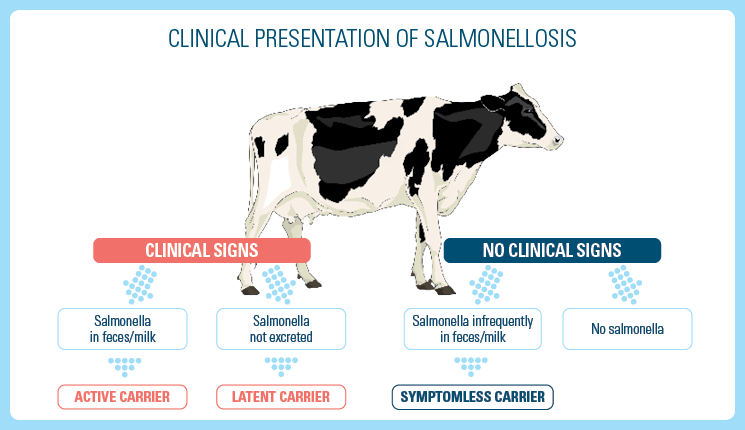

Salmonellosis
Salmonellosis is an infectious disease caused by Salmonella spp in animals and humans. A significant foodborne pathogen, salmonellosis has different manifestations in cattle that range from asymptomatic to severe bacteremia.
The common salmonella serotypes of concern to bovine practitioners are Salmonella dublin, montevideo, and typhimurium. The host adapted serotype Salmonella dublin in cattle has become increasingly problematic in recent years, because it can lead to lifelong infection in cattle with intermittent periods of bacteremia and shedding1.
- Fecal-oral transmission, usually from infected cows
- Aerosol transmission
- Saliva and nasal secretions
- Milk and colostrum
Cows infected with salmonella may or may not exhibit clinical signs of infection. Whether cattle exhibit clinical signs of infection or not, it is a serious threat to cattle producers because of reduced milk production and herd performance.

Young Stock
Enteric, septicemic and reproductive diseases are all possible manifestations of a salmonella infection, with pneumonia being a common manifestation of Salmonella dublin infection in calves. Common clinical signs of salmonellosis include2:
- Pyrexia
- Depression
- Decreased milk production
- Dehydration
- Diarrhea progressing to disentery
- Joint infections
- Chronic pneumonia
- Abortion
- Sudden death
Salmonella can cause reproductive losses that typically include abortion in late pregnancy. However, poor reproductive performance is also problematic and leads to prolonged lactations, excessive body condition in late lactation and risk of metabolic disease at calving.
S. dublin is the most common serotype associated with abortion and occurs between months 5 and 8 of the pregnancy with placental retention followed by poor lactation. Systemic disease is uncommon with this serotype, but is likely to occur with S. typhimurium where abortion can follow septicemia and enteritis.
Salmonellosis in dairy cattle commonly occurs close to parturition.
Diagnosis is based on detection of the bacteria through aerobic culture of feces or detection of genetic material from the bacteria via PCR techniques.
Serological tests are available, but they are not particularly specific or sensitive.
Fluid therapy is recommended for cattle with enteric salmonellosis, while antimicrobial therapy remains controversial. To reduce the risk of salmonella infections in cattle:
- Minimize fecal contamination of feedstuffs, feeding surfaces, water troughs, and equipment.
- Maximize host resistance of susceptible animals.
- Control of the environment that can perpetuate the organism – rodents, flies, nuisance birds, feral dogs, and cats.
- Avoid introducing potentially infected animals.
- Isolate sick animals.
- Clean and disinfect buildings between occupancies.
- Protect all feed stores from vermin including birds.
- Look for development of newer vaccines that target signaling pathways and other unique strategies rather than relying on conventional bacterins for prevention and control.
To avoid salmonellosis in humans2:
- Use protective clothing when entering a farm.
- Use gloves and protective wear.
- Hand washing.
- Do not drink raw milk.
- Holschbach CL, Peek SF. Salmonella in Dairy Cattle. 2018. Veterinary Clinics of North America: Food Animal Practice 34 (1):133-154.
- McGuirk SM, Peek SF. Salmonellosis in cattle: A Review. Preconvention Seminar 7: Dairy Herd Problem Investigation Strategies. American Association of Bovine Practitioners. 36th Annual Conference, September 15-17, 2003 – Columbus, OH.

